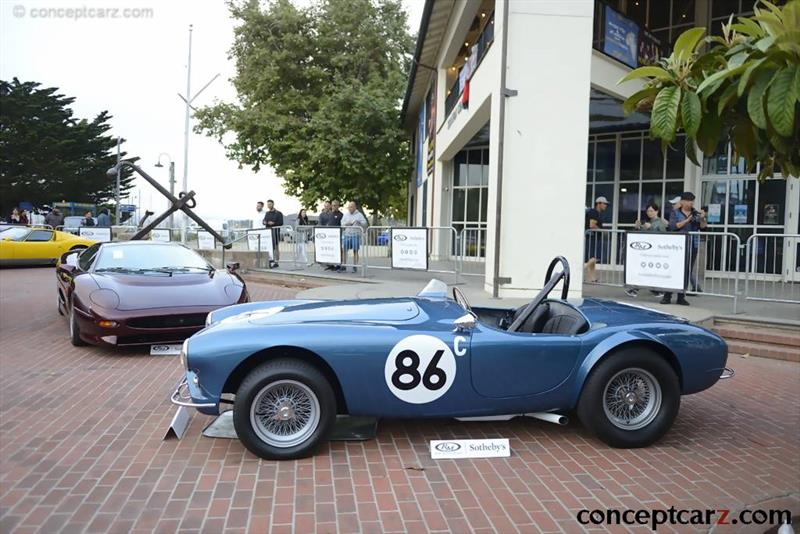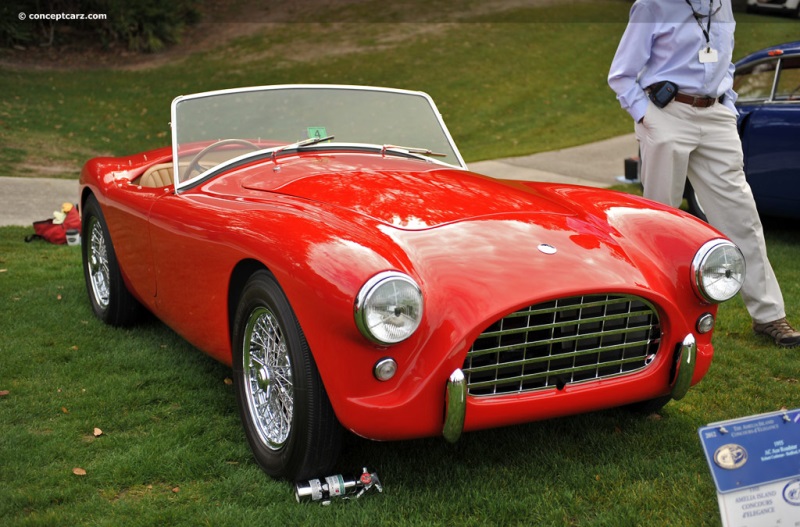The AC Ace roadster was introduced in 1953 at the London Motor Show, instantly transforming the staid British company into a manufacturer of sporty automobiles.
The Tojeiro Barchetta
The Ace's legacy began several years earlier when Cliff Davies commissioned John Tojeiro in the early-1950s to build him a car with a two-liter, Bristol six-cylinder engine. The car was registered as 'LOY 500' and was bodied by Panelcraft with a design inspired by the Ferrari 166 MM Barchetta. The Bristol engine was a development of the BMW 328 and offered nearly 130 horsepower. The chassis was a twin-tube ladder frame with a Cooper-influenced all-independent suspension. The entire package weighed approximately 1,180 pounds.
LOY 500 was followed by 'LOY 501', another Tojeiro-built Barchetta but with MG power. An additional - possibly two or more - cars followed, one of which may have been an MG-powered example registered as 'LOW 77' and the other was Vin Davison's LER 371, which was being built with a Lea-Francis engine. Around this time, Tojeiro was working for Ernie Bailey at Buckland Bodyworks, which was supplying bodies for AC. Mr. Bailey suggested that AC might be interested in Tojeiro's design. Inspired, Mr. Tojeiro drove Davies' Bristol-powered (LOY 500) to the AC Works at Thames Ditton, and the timing was perfect, as AC was seeking a car they could display at the upcoming 1953 Earls Motor Court motor show. The car shown was 'LER 371', but its Lea-Francis engine was replaced with one of AC's own engines. The car was painted blue and re-registered as TPL 792. A young Texas-based racer (and chicken farmer) named Carroll Shelby would later shoehorn a 289 cubic-inch eight-cylinder engine under the bonnet of the Ace Ace, creating the Shelby Cobra.
The AC Ace
The AC Ace retained Tojeiro's twin-tube setup and independent suspension, but the engine was AC's own 2.0-liter, long-stroke six. The origins of this overhead-camshaft unit dated to 1919, and the unit installed in the Ace initially produced a modest 80 bhp, later growing to 100 bhp. Compared to the modern chassis and suspension, the engine was rather anemic. This was later rectified with Ford's eight-cylinder engine. The AC Ace rested on a 90-inch wheelbase that stood 49 inches tall, was 59.5 inches wide, and had a 152-inch length. The roadster was joined in 1954 by the Aceca hardtop coupe.
From 1956 forward, AC offered the option of Bristol Cars' two-liter straight-six with three downdraught carburetors and 120 bhp. The 1,971cc Bristol six was based on the prewar BMW 328 with a cylinder head designed by Rudolf Schleicher. It had hemispherical combustion chambers and inclined valves, and the earlier BMW Type 319 engine's single block-mounted camshaft and pushrod valve actuation. Each of the two rocker shafts was situated above each bank of valves, giving it the appearance of a twin-overhead-cam design. This engine was popular during the 1950s, most notably by Cooper, due to its tune-ability and durability partly attributed to the use of high-quality materials.
With the Bristol engine installed, the car could reach 120 mph. This allowed the Ace to achieve numerous successes in production sports car racing, and among the accolades was a first-in-class and seventh-overall finish in 1959 at the 24 Hours of Le Mans.
An overdrive transmission became available in 1956 and front disc brakes were optional from 1957, and later standardized. In 1961, a 2.6-liter straight-six 'Ruddspeed' was offered, adapted by Ken Rudd from the engine installed in the Ford Zephyr. Depending on the configuration, the output reached 170 bhp which boosted the top speed to 130 mph.
A total of 223 examples were delivered with the 2.0-liter AC engine, 463 with Bristol power, and 37 with the Ford 'Rudd' engines. The cars equipped with the Ford engine had smaller grilles which were later used on the Cobra.
by Daniel Vaughan | Dec 2022
The Tojeiro Barchetta
The Ace's legacy began several years earlier when Cliff Davies commissioned John Tojeiro in the early-1950s to build him a car with a two-liter, Bristol six-cylinder engine. The car was registered as 'LOY 500' and was bodied by Panelcraft with a design inspired by the Ferrari 166 MM Barchetta. The Bristol engine was a development of the BMW 328 and offered nearly 130 horsepower. The chassis was a twin-tube ladder frame with a Cooper-influenced all-independent suspension. The entire package weighed approximately 1,180 pounds.
LOY 500 was followed by 'LOY 501', another Tojeiro-built Barchetta but with MG power. An additional - possibly two or more - cars followed, one of which may have been an MG-powered example registered as 'LOW 77' and the other was Vin Davison's LER 371, which was being built with a Lea-Francis engine. Around this time, Tojeiro was working for Ernie Bailey at Buckland Bodyworks, which was supplying bodies for AC. Mr. Bailey suggested that AC might be interested in Tojeiro's design. Inspired, Mr. Tojeiro drove Davies' Bristol-powered (LOY 500) to the AC Works at Thames Ditton, and the timing was perfect, as AC was seeking a car they could display at the upcoming 1953 Earls Motor Court motor show. The car shown was 'LER 371', but its Lea-Francis engine was replaced with one of AC's own engines. The car was painted blue and re-registered as TPL 792. A young Texas-based racer (and chicken farmer) named Carroll Shelby would later shoehorn a 289 cubic-inch eight-cylinder engine under the bonnet of the Ace Ace, creating the Shelby Cobra.
The AC Ace
The AC Ace retained Tojeiro's twin-tube setup and independent suspension, but the engine was AC's own 2.0-liter, long-stroke six. The origins of this overhead-camshaft unit dated to 1919, and the unit installed in the Ace initially produced a modest 80 bhp, later growing to 100 bhp. Compared to the modern chassis and suspension, the engine was rather anemic. This was later rectified with Ford's eight-cylinder engine. The AC Ace rested on a 90-inch wheelbase that stood 49 inches tall, was 59.5 inches wide, and had a 152-inch length. The roadster was joined in 1954 by the Aceca hardtop coupe.
From 1956 forward, AC offered the option of Bristol Cars' two-liter straight-six with three downdraught carburetors and 120 bhp. The 1,971cc Bristol six was based on the prewar BMW 328 with a cylinder head designed by Rudolf Schleicher. It had hemispherical combustion chambers and inclined valves, and the earlier BMW Type 319 engine's single block-mounted camshaft and pushrod valve actuation. Each of the two rocker shafts was situated above each bank of valves, giving it the appearance of a twin-overhead-cam design. This engine was popular during the 1950s, most notably by Cooper, due to its tune-ability and durability partly attributed to the use of high-quality materials.
With the Bristol engine installed, the car could reach 120 mph. This allowed the Ace to achieve numerous successes in production sports car racing, and among the accolades was a first-in-class and seventh-overall finish in 1959 at the 24 Hours of Le Mans.
An overdrive transmission became available in 1956 and front disc brakes were optional from 1957, and later standardized. In 1961, a 2.6-liter straight-six 'Ruddspeed' was offered, adapted by Ken Rudd from the engine installed in the Ford Zephyr. Depending on the configuration, the output reached 170 bhp which boosted the top speed to 130 mph.
A total of 223 examples were delivered with the 2.0-liter AC engine, 463 with Bristol power, and 37 with the Ford 'Rudd' engines. The cars equipped with the Ford engine had smaller grilles which were later used on the Cobra.
by Daniel Vaughan | Dec 2022
Related Reading : AC Ace History
The Ace was introduced in 1953 at the London Motor Show and was produced beginning in 1954 and continuing through 1963. The vehicle consisted of lightweight tubular chassis with steel boxes in the front and rear which supported a transverse leaf and lower wishbone independent suspension system. The chassis was designed by John Tojeiro. Power was initially provided by a Welleter-designed engine and....
Continue Reading >>
Continue Reading >>
Related Reading : AC Ace History
The oldest British car manufacturer, AC has continuously produced vehicles since 1901 and the marque carries enormous prestige. The AC Aceca, a closed coupe, was unveiled in 1954 in London and only 328 prototypes were ever produced. Production of the Aceca Coupe commenced in 1955 and Le Mans 1957 was a lucrative one for AC, with an AC Bristol finishing tenth overall. 1958 was an even better year....
Continue Reading >>
Continue Reading >>
Similar Vehicles
Similarly Sized Vehicles
from 1955
Similarly Priced Vehicles
- Jaguar XK-140 ($3,455-$4,100)
Average Auction Sale: $162,023
1955 AC Ace Vehicle Profiles
Recent Vehicle Additions
Performance and Specification Comparison
Price Comparison
$4,500
Ace Specification Comparison by Year
Year
Production
Wheelbase
Engine
Prices
Related Automotive News

THE LIGHTWEIGHT E-TYPE IS REBORN
Jaguar is to build six brand new Lightweight E-types – the missing six Lightweights that were never built from the intended 18-car series
The Jaguar brands first ever re-creation project, the all-aluminum cars, will be assigned the six remai...

JAGUAR LAND ROVER WINS BOTH AUTOBYTEL CAR OF THE YEAR AND TRUCK OF THE YEAR
Jaguar F-TYPE wins 2014 Car Of The Year and Convertible of the Year
2014 Range Rover wins 2014 Truck Of The Year and Luxury SUV of the Year
(MAHWAH, N.J.) - January 2, 2014 - Jaguar Land Rover North America, LLC announced today that...

All-New Jaguar F-Type & 2013 Range Rover Autobiography Named To 25Th Robb Report Annual ‘Best Of The Best' List
Jaguar F-TYPE V8 S announced as winner of Convertible category
Range Rover Autobiography announced as winner of Sport Utility Vehicle category
(MAHWAH, N.J.) – June 3, 2013 – Jaguar Land Rover North America announced today that the Jaguar F-T...

ACURA NSX PRODUCTION SITE SELECTED IN OHIO
05142013 - MARYSVILLE, Ohio
Acura today announced that the all-new NSX supercar will be produced at a new Performance Manufacturing Center in Ohio, a %2470 million advanced production facility encompassing 184,000 square feet to be housed inside...

Jaguar Land Rover Debuts Three All-New British Vehicles At 2012 Los Angeles International Automobile Show
Jaguar Land Rover introducing three new vehicles with special focus on the U.S. Market
High-performance 2014 Jaguar XFR-S makes its world debut
All-new two-seat sports car, the Jaguar F-TYPE, makes its U.S. Auto Show Debut
The worlds first all...
















